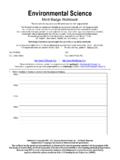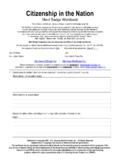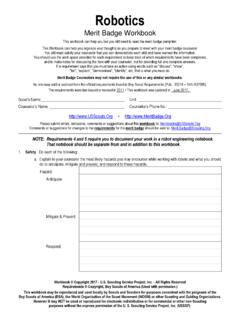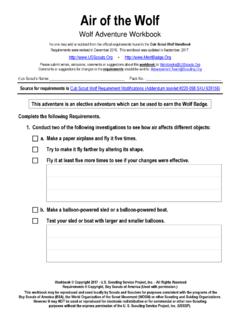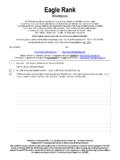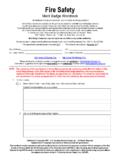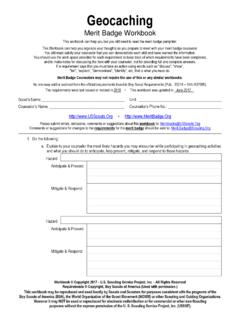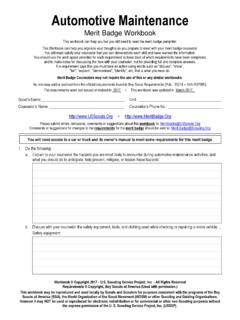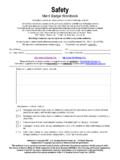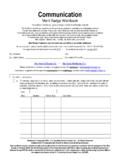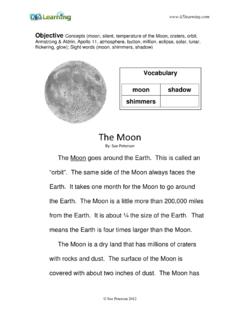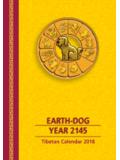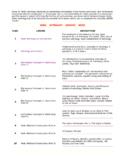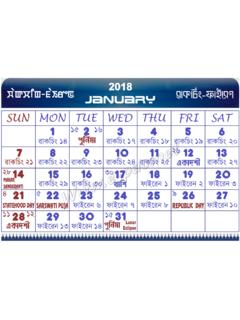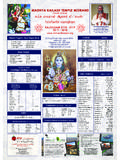Transcription of Astronomy - usscouts.org
1 Astronomy Merit Badge Workbook This workbook can help you but you still need to read the merit badge pamphlet. This Workbook can help you organize your thoughts as you prepare to meet with your merit badge counselor. You still must satisfy your counselor that you can demonstrate each skill and have learned the information. You should use the work space provided for each requirement to keep track of which requirements have been completed, and to make notes for discussing the item with your counselor, not for providing full and complete answers. If a requirement says that you must take an action using words such as "discuss", "show", "tell", "explain", "demonstrate", "identify", etc, that is what you must do.
2 Merit Badge Counselors may not require the use of this or any similar one may add or subtract from the official requirements found in Boy Scout Requirements (Pub. 33216 SKU 637685). The requirements were last issued or revised in 2018 This workbook was updated in March 2018. Scout s Name: _____ Unit: _____ Counselor s Name: _____ Counselor s Phone No.: _____ Workbook Copyright 2018 - Scouting Service Project, Inc. - All Rights Reserved Requirements Copyright, Boy Scouts of America (Used with permission.) This workbook may be reproduced and used locally by Scouts and Scouters for purposes consistent with the programs of the Boy Scouts of America (BSA), the World Organization of the Scout Movement (WOSM) or other Scouting and Guiding Organizations.
3 However it may NOT be used or reproduced for electronic redistribution or for commercial or other non-Scouting purposes without the express permission of the U. S. Scouting Service Project, Inc. (USSSP). submit errors, omissions, comments or suggestions about this workbook to: or suggestions for changes to the requirements for the merit badge should be sent to: the following: a. Explain to your counselor the most likely hazards you may encounter while participating in Astronomy activities, and what you should do to anticipate, help prevent, mitigate, and respond to these hazards. Hazards: What you should do: AstronomyScout's Name: _____Astronomy - Merit Badge WorkbookPage.
4 2 of first aid for injuries or illnesses such as heat and cold reactions, dehydration, bites and stings, and damage toyour eyes that could occur during reactions:Cold reactions;Dehydration;Bites andstings:Damage to the proper clothing and other precautions for safely making observations at night and in cold :Cold Weather:AstronomyScout's Name: _____Astronomy - Merit Badge WorkbookPage. 3 of 13 Then explain how to safely observe the Sun, objects near the Sun, and the what light pollution is and how it and air pollution affect the aid of diagrams (or real telescopes if available), do each of the why binoculars and telescopes are important astronomical or explain how these tools are 's Name: _____Astronomy - Merit Badge WorkbookPage.
5 4 of the similarities and differences of several types of astronomical telescopes, including at least one that observeslight beyond the visible part of the spectrum ( , radio, X-ray, ultraviolet, or infrared). the purposes of at least three instruments used with astronomical the proper care and storage of telescopes and binoculars both at home and in the Do the following:* in the sky at least 10 constellations, at least four of which are in the zodiac. 1. 2. 3. 4. 5. 6. 7. 8. 9. Scout's Name: _____ Astronomy - Merit Badge Workbook Page 5 of 13b. Identify in the sky at least eight conspicuous stars, five of which are of magnitude I or brighter. Name of star Magnitude 1 or brighter?
6 1. 2. 3. 4. 5. 6. 7. Make two sketches of the Big Dipper. In one sketch, show the Big Dipper s orientation in the early evening sky. In another sketch, show its position several hours later. In both sketches, show the North Star and the horizon. Record the date and time each sketch was made. Date:___/___/___ Time: _____ Date:___/___/___ Time: _____ North Star WestNorthEastSuggested procedure:Choose a clear night when you will have time and the ability to make observations some hours apart. Looking north, draw the position of the Big Dipper with relation to the North Star. Note the time next to it. Several hours later (six hours are best but at least four hours and preferably more than five hours) draw the position of the big dipper with relation of the North Star and note the time next to it.
7 (Be sure to clearly identify which diagram represents which observation)* For requirement 4, if instruction is done in a planetarium, Scouts must still identify the required stars and constellations under the natural night sky. Astronomy Scout's Name: _____ Astronomy - Merit Badge Workbook Page 6 of 13d. Explain what we see when we look at the Milky Way. 5. Do the following: a. List the names of the five most visible planets. Explain which ones can appear in phases similar to lunar phases and which ones cannot, and explain why. Five Most Visible Planets Phases? Why? b. Using the Internet (with your parent's permission), books, and other resources, find out when each of the five most visible planets that you identified in requirement 5a will be observable in the evening sky during the next 12 months, then compile this information in the form of a chart or table.
8 Planet NameMonthJanuaryFebruaryMarchAprilMayJun e JulyAugustSeptember OctoberNovemberDecember AstronomyScout's Name: _____Astronomy - Merit Badge WorkbookPage. 7 of the motion of the planets across the a planet and describe what you the the face of the Moon and indicate at least five seas and five craters. Label these Scout's Name: _____ Astronomy - Merit Badge Workbook Page 8 of 13b. Sketch the phase and position of the Moon, at the same hour and place, for four nights within a one week period. Include landmarks on the horizon such as hills, trees, and buildings. Date:___/___/___ Time: _____ Date:___/___/___ Time: _____ Date:___/___/___ Time: _____ Date:___/___/___ Time: _____East South West Suggested procedure: First check to see whether it is a morning or evening moon and chose a time to view the moon.
9 Avoid an observation period when there will be a new moon. Choose a time and place you are going to be able to observe the moon each day. On the first day, sketch the relative position of the moon across the southern horizon noting its height and shape (phase). Draw some landmarks on the sketch as points of reference. On the same drawing, repeat this at the same time each day for the next three days, showing the height and shape of the moon for each observation. Note the date and time of your observation next to each sketch of the moon. If the sky is overcast and the moon is not visible, either extend the observations until you can make four of them, and/or using the other observations, estimate where the moon would have been and what shape it would have been on the overcast day(s) and indicate that what isan estimate due to overcast sky.
10 Explain the changes you observe. AstronomyScout's Name: _____Astronomy - Merit Badge WorkbookPage. 9 of the factors that keep the Moon in orbit around the aid of diagrams, explain the relative positions of the Sun, Earth, and the Moon at the times of lunar and solareclipses, and at the times of new, first-quarter, full, and last-quarter phases of the s Note: These diagrams can be used to show the relative positions of the Sun, Earth, and Moon during the new,first-quarter, full, and last-quarter phases of the Moon as well as during the WaxingGibbous , WaningGibbous , WaxingCrescent , and WaningCrescent phases of the Moon (which is not required for the merit badge). Two of thediagrams can be used to show the positions both for a phase of the Moon and during an Scout's Name: _____ Astronomy - Merit Badge Workbook Page.
